
by Dave Wells
Photos taken
during July-August 1999.

by Dave Wells
Photos taken
during July-August 1999.
Like many developing
nations there is not a large "middle class" in the Philippines. A small
percentage of the population owns vast amounts of wealth and lives quite
well, even by U.S. standards. The photos below show Forbes Park, one of
the gated communities around Makati, the business center of Manila. You
also see two photos of the same home taken from different angles. Notice
how far back it goes into the property and how many "normal" sized Phoenix-area
homes might fit inside!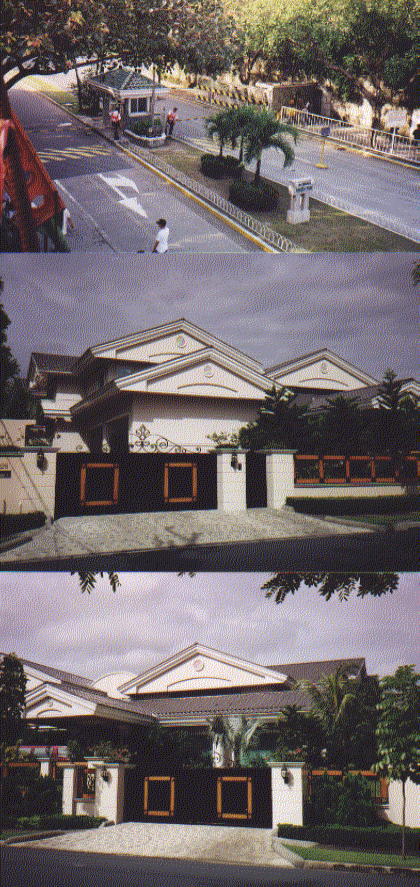 The wealthy live in gated communities, so common Filipinos cannot enter
unless they work in the homes. The Philippine minimum wage at the time
of our visit was 140 pesos per day. At an exchange rate of 40 pesos
to the dollar this equated to $3.50 (notice from the case study that the
dollar value of the minimum wage has been declining since 1990). After
we left, my brother rented an approx. 4,000 sq. ft. home for approximately
$1200/month in a neighborhood a bit farther away and not quite as ritzy
(one year's rent is paid in advance). It would take the maid who worked
in that home 343 days at the minimum wage she is paid to pay for one month’s
rent.
The wealthy live in gated communities, so common Filipinos cannot enter
unless they work in the homes. The Philippine minimum wage at the time
of our visit was 140 pesos per day. At an exchange rate of 40 pesos
to the dollar this equated to $3.50 (notice from the case study that the
dollar value of the minimum wage has been declining since 1990). After
we left, my brother rented an approx. 4,000 sq. ft. home for approximately
$1200/month in a neighborhood a bit farther away and not quite as ritzy
(one year's rent is paid in advance). It would take the maid who worked
in that home 343 days at the minimum wage she is paid to pay for one month’s
rent.
![]()
Jeepney factory
outside Manila. No assembly lines exist, although the work is broken down
into separate task areas. The plant employed only men. The observed pace
of work was not too strenuous and pay levels unknown. The United States
Army Jeeps left after WW2 were refurbished, extended in the back and turned
into colorful forms (with bright paint) of public transportation. A Jeepney
ride along a major road in Manila costs around 10 pesos (one quarter US)
and are usually filled to the brim with passengers.
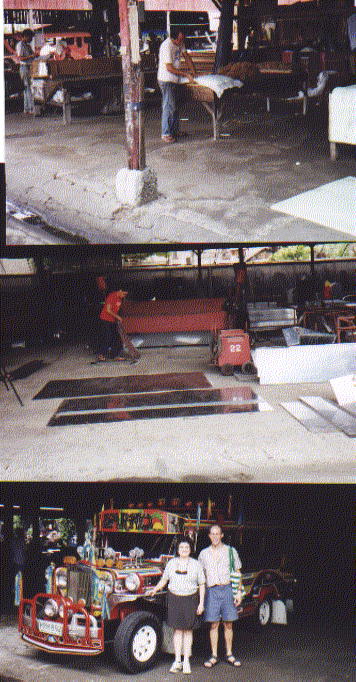
The Jeepney shown
is quite elaborate by Philippine standards and is probably one that will
be run by private reservation only. Notice all the "extras" mounted on
this Jeepney! We also observed one Jeepney that highlighted as an amenity
"three horses on the hood"—and yes that referred to
the metal horses on the hood, not the engine!
![]()
Rice loaded on a bus near Kalibo (small rural city on a less populated island south of the island where Manila is located and north of the island where Cebu is located). Bus rides for longer trips are also a fairly inexpensive means of transportation, packed with people, and not air-conditioned. We stopped on occasion to have roofing materials and rice loaded on the top. Rice is the primary agricultural crop in the Philippines (above is a picture of similar bus in Manila).
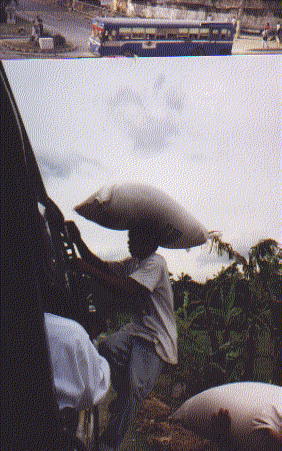
![]()
Fabric made from Pineapple! Or banana, but pineapple is more precious (incidentally that's rice out to dry below, not pineapple).
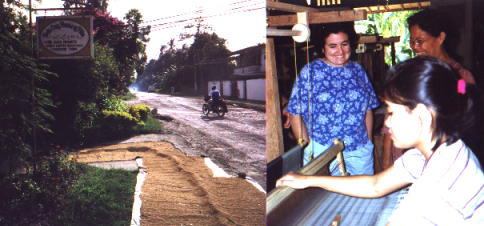
Pina cloth comes from the leaves of the pineapple.
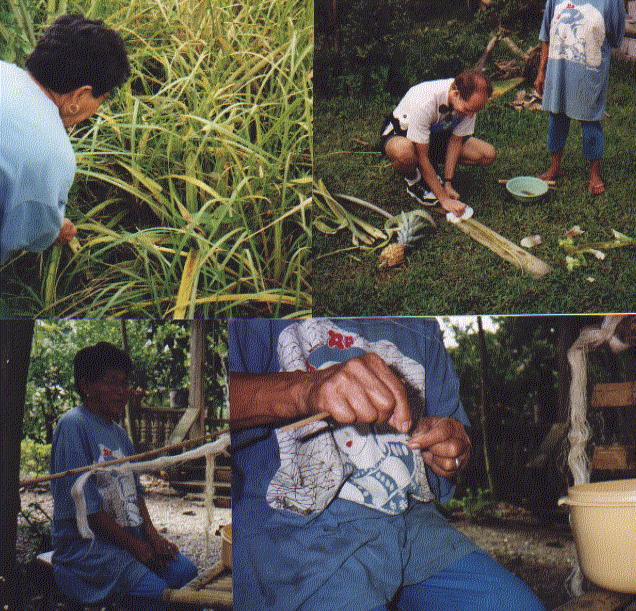
The leaves are scraped twice for the finer and coarser threads (I thank her for not laughing at my feeble efforts!). She can strip 1,000 leaves in a day! Threads are then gathered (shown), washed, dried and knotted together before weaving. Quite labor intensive with products sold not only in the Philippines, as 80% are sold in US and Japan—Pina tablecloth with place settings can be $400 (US) made with the coarser fibers. Finer fibers used for clothing. This industry primarily employs women.
This woman’s
family does the lower end of creating thread. To me it looked like the
most difficult job with the repeated knot tying aspect to create thread,
but it actually paid less than the weavers, since it was considered a lower
skill. A single person who is adept at knot tying could earn 150-175 pesos
per day in 1999 creating thread—with 90% of the time
devoted to knotting. Given the lower cost of living in a rural area, this
source of earnings can be significant. This family has been able to build
a concrete block home and purchase two motorized-tricycles/taxis. The two
men in the family now ride those vehicles to earn added income.
![]()
While in Kalibo, we visited a small loosely organized group of crafts people selling these Nipa-weaved vases to Ethan Allen! Ethan Allen pays approx. $40 for each vase and sells it in the catalog (on sale, by the way) for $299. Ethan Allen contacted them via a trade show in Manila and worked with them on a custom design for the vase. This was their fourth shipment of 600 vases (my brother and the man--his wife coordinates the business as well--who works on coordinating the business and our tour guide are pictured).
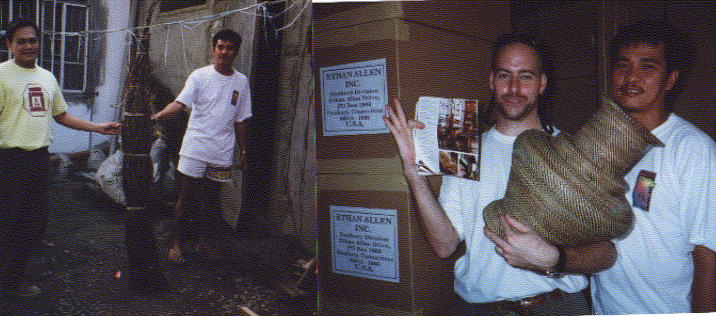
The $40 is essentially twice what the workers would earn making other (smaller) items for the Philippine market only. Normally, weavers earn approx. 400 pesos per week, if selling only to the Philippine market. With the Ethan Allen contract, they made approximately 900 pesos per week working in their own home.
In both the Ethan Allen vase and pina cloth examples, workers in small businesses benefit by being able to sell their product via an importer to fairly wealthy consumers in a major economic region (Western Europe, Japan and United States). Economists argue that international trade between a wealthy economy and a less developed economy does serve to enrich both buyer and seller alike. The wealthy economy buyer gets a better deal, and the less developed economy seller receives more income. However, as you can see with the Ethan Allen case, underlying economic power can shift the relative gains toward the more powerful and well-connected party.
__________________________________________________________________
Unfortunately, with a growing population and the relative prices of agricultural food crops lagging behind the cost of other consumer items, there remains a lack of adequately paid work in rural areas. So many migrate to urban centers like Manila and Cebu in hopes of finding better employment. But it doesn't necessarily work out that way. Shown below is squatter housing along the Pasig River in Manila.
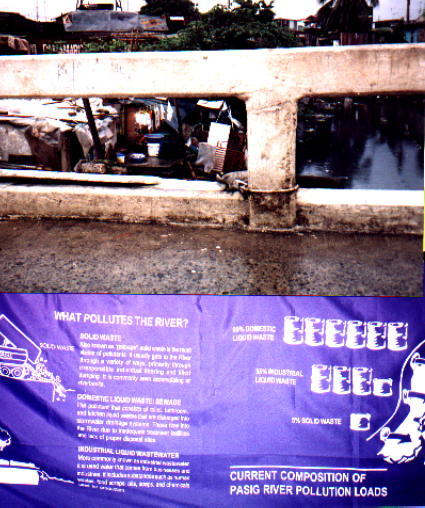
At least one
million people live this way there. Most of these people are informally
employed by offering wares or labor services on the streets frequently
and end up living along a water supply (that is also their sewer). They
can squat in this area, though flood danger is present, and the river due
to waste (human and industrial) is biologically dead.
![]()
Self-made housing built out of scrap wood materials by construction workers working on twin 40-story towers in the Makati section of Manila (business center). The construction company provided the scrap wood to the workers, who are brought in from rural provinces to work for a subminimum wage (approx. 120 pesos or $3.00 US per day), which is legal since some meals are provided by the employer. Workers would carry buckets (formerly large paint containers) to a hose by the construction site to fill up with water for daily needs. They would also bathe by this hose.
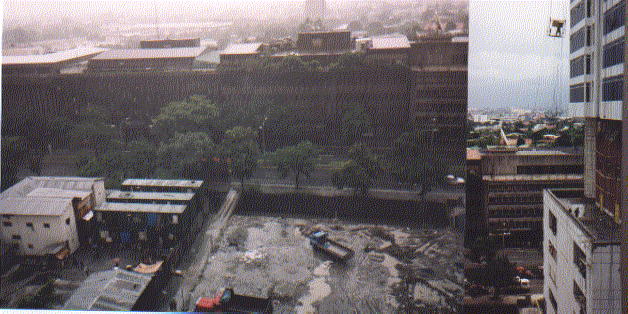
Well, that's it for your brief tour of the Philippines!
Sources:
Information here based
on interviews with people affiliated with the organization directly except
for the construction worker case—which was a best guess by my brother,
who had lived in Manila for three years at the time of the visit. The number
of squatters in Manila is based on an estimated minimum housing shortage
of 0.6 million units in 1988 (a problem that is probably growing and a
unit holds an entire family) as reported by Marlene V. Gatpatan in "The
City’s Homeless: Issues on the Human Rights of Shelter," Human Rights
Forum, January-June 1998, pp. 8-15.